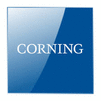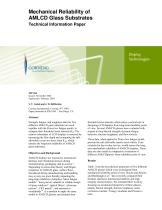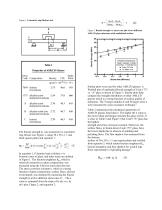
Catalog excerpts

Mechanical Reliability of AMLCD Glass Substrates Technical Information Paper TIP 204 Issued: November 2004 Supercedes: February 2003 S. T. Gulati and J. D. Helfinstine Corning Incorporated, Corning, NY 14831 Paper presented at SID 1996 – San Diego, CA Abstract Strength, fatigue, and toughness data for five different AMLCD glass substrates are used, together with the Power law fatigue model, to compute their threshold stress intensity KI0. The relative robustness of LCD displays is assessed by measuring the flaw depth and computing the safe allowable in-service stress from K I0, which ensures the long-term reliability of AMLCD glass substrates. Objectives and Background AMLCD displays are exposed to mechanical, thermal, and vibrational stresses during manufacturing, packaging, and in-service1,2 . Depending on stress-time history and fatigue properties of AMLCD glass, surface flaws introduced during manufacturing and handling may or may not grow thereby impacting the long-term reliability of displays. Since fatigue models3-5 have proven valuable in reliable design of space windows6 , optical fibers7 , telescope mirrors8 , CRT panels9 , and automotive windshields10 , it is prudent to apply the same model to AMLCD glasses and estimate their threshold stress intensity which plays a critical role in designing LCD displays from long-term durability point of view. Several AMLCD glasses were evaluated with respect to their biaxial strength, dynamic fatigue behavior, fracture toughness, and flaw severity. These data, when applied to Power law fatigue model, provide the safe allowable tensile stress which, if not exceeded in day-to-day service, would ensure the longterm mechanical reliability of AMLCD displays. These data are also useful in comparative evaluation of different AMLCDglasses from reliability point of view. Results Table 1 lists the key physical properties of five different AMLCD glasses which were investigated from mechanical reliability point of view. Bocko and Allaire1 and Dumbaugh et al11 have recently compared their thermal, chemical, dimensional stability and edge integrity characteristics. We extended their work by focusing on mechanical properties of these glasses, namely biaxial strength, fracture toughness, stress corrosion constant, Young’s modulus and Poisson’s ratio.
Open the catalog to page 1
Cork CVmiposiLlon Dentin d"fc l\i\m hnr<]«i li.nl.- The biaxial strength was measured in a concentric ring flexure test, Figure 1, using 50 x 50 x 1.1 mm thick square plates and equation 1: In equation 1, denotes load at failure, is Poisson's ratio of glass, and other terms are defined in Figure 1. The fracture toughness Kic, which is relatively insensitive to glass composition, was measured using the Chevron notch short bar test. The stress corrosion constant , which is a strong function of glass composition, surface flaws, and test environment, was obtained by measuring the biaxial...
Open the catalog to page 2
M.jL-huUKJI IVii|h;|-|U:h uTAMLT it i i\LUdX ('■■■j.- l.v|i:h ('■.■ - Jill 11 -11;: 1111.- -- -- I ■ --: 111111 -. H.iln- Biaxial Strength |WPJ> The threshold stress intensity KIo and safe allowable stress , were then estimated from KTc, and Table 3 summarizes Kfo / Kic, 0 / values for the five AMLCD glasses. It should be noted that,once again, Code 1737 glass permits the highest safe allowable stress in service, i.e. its long-term mechanical reliability and robustness are the best among the five glasses studied here. A static stress equal to 42% of biaxial applied to Code 1737 AMLCD...
Open the catalog to page 3
References 1. Bocko, P.L. and Allaire, R.A.; "Glass Contribution to Robustness of Displays for Automotive Applications;" 1995 Symposium on Vehicle Displays sponsored by Detroit Metropolitan Chapter of Society for Information Display, Ypsilanti, MI, November 2, 1995. 2. Ghosh, A.; Gulati, S. T; and Helfinstine, JD.; "Review of Requirements of Glass for AMLCDs for Vehicle Display Applications and Fatigue Behavior of LCD Glass;" 1995 Symposium on Vehicle Displays sponsored by Detroit Metropolitan Chapter of Society for Information Display, Ypsilanti, MI,- November 2, 1995. 11 Dumbaugh W.H.;...
Open the catalog to page 4
North America and all other Countries Corning Display Technologies MP-HQ-W1 Corning, NY 14831 United States Telephone: +1 607-974-9000 Fax: +1 607-974-7097 Internet: www.corning.com/displaytechnologies Japan Corning Japan K.K. Main Office No. 35 Kowa Building, 1st Floor 1-14-14, Akasaka Minato-Ku, Tokyo 107-0052 Japan Telephone: +81 3-5562-2260 Fax: +81 3-5562-2263 Internet: www.corning.co.jp Nagoya Sales Office Nagoya Bldg., 7 F 4-6-18, Mei-eki, Nakamura-ku Nagoya-shi, Aichi 450-0002 Japan Telephone: +81 52-561-0341 Fax: +81 52-561-0348 China Corning (China) Ltd., Shanghai Representative...
Open the catalog to page 5All CORNING Display Technologies catalogs and technical brochures
-
Gorilla® Glass 5
2 Pages
-
Corning Iris®
2 Pages
-
Aspheres by Corning
2 Pages
-
UltraFlat™
2 Pages
-
Tropel® FlatMaster® MSP
2 Pages
-
Optical Solutions
4 Pages
-
EAGLE XG® Slim
2 Pages
-
Scoring of AMLCD Glass
4 Pages
Archived catalogs
-
Jade® Product Information Sheet
3 Pages
-
Jade® Material Information Sheet
2 Pages

































